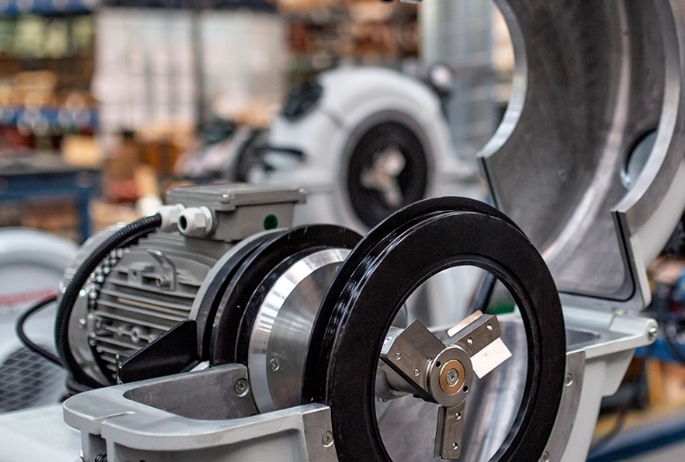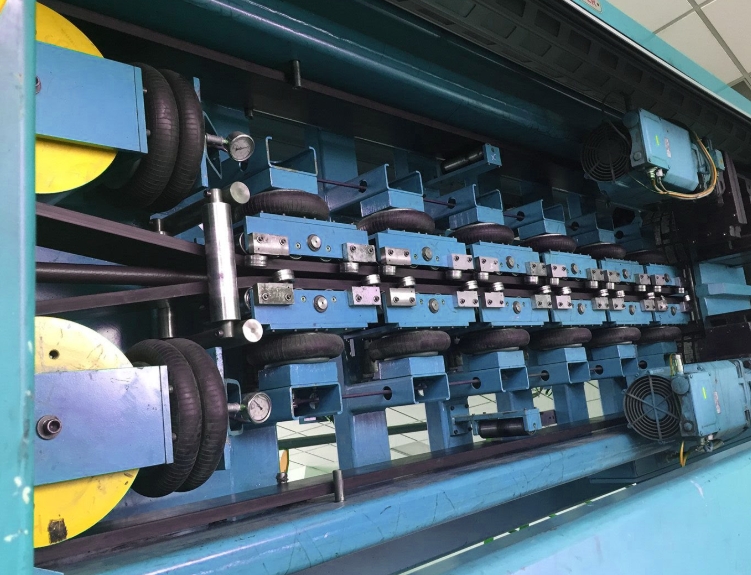Content Menu
● Understanding Film Extrusion and Downstream Equipment
● Materials Processed Using Film Extrusion Downstream Equipment
>> Polyethylene (PE)
>> Polypropylene (PP)
>> Polyvinyl Chloride (PVC)
>> Polyethylene Terephthalate (PET)
>> Ethylene Vinyl Acetate (EVA)
>> Other Specialty Polymers
● Key Downstream Equipment for Film Extrusion
>> Cooling Systems
>> Pullers and Haul-Offs
>> Cutting and Slitting Equipment
>> Winding Systems
>> Inspection and Measurement Devices
● Applications of Film Extrusion Downstream Equipment
>> Packaging Industry
>> Industrial and Technical Films
>> Consumer Goods
>> Specialty Applications
● Challenges and Considerations in Film Extrusion Downstream Processing
● Conclusion
● FAQ
>> 1. What types of polymers are best suited for film extrusion downstream equipment?
>> 2. How does cooling affect the quality of extruded film?
>> 3. Can film extrusion downstream equipment handle recycled materials?
>> 4. What role do pullers play in film extrusion downstream lines?
>> 5. Are downstream equipment systems customizable for specific applications?
● Citations:
Film extrusion downstream equipment plays a crucial role in the plastic extrusion industry by transforming molten polymer into finished films and sheets with precise dimensions and desired physical properties. This article explores the variety of materials that can be processed using film extrusion downstream equipment, the types of equipment involved, their applications, and how these systems ensure quality and efficiency in production.

Understanding Film Extrusion and Downstream Equipment
Film extrusion is a process where thermoplastic polymers are melted and formed into thin films or sheets through a die. The downstream equipment refers to all machinery and devices that handle the extruded film after it exits the die, including cooling, pulling, cutting, winding, and inspection systems. These components are vital to maintaining the film's shape, thickness, surface quality, and overall performance.
The downstream equipment typically includes:
- Cooling systems such as water tanks, spray cooling, or vacuum cooling to solidify and stabilize the film.
- Pullers that control the film speed and tension to avoid deformation.
- Cutters and slitters for trimming films to width or cutting into specified lengths.
- Winders that roll the finished film onto cores for storage and transport.
- Inspection and measuring devices to ensure dimensional and quality consistency.
Together, these systems enable the efficient production of films with tight tolerances and consistent quality[1][3][4][6].
Materials Processed Using Film Extrusion Downstream Equipment
Film extrusion downstream equipment is versatile and can process a wide range of thermoplastic materials. The choice of material depends on the application requirements such as flexibility, strength, clarity, barrier properties, and chemical resistance. Common materials include:
Polyethylene (PE)
- Low-Density Polyethylene (LDPE) and Linear Low-Density Polyethylene (LLDPE) are widely used for packaging films, agricultural films, and shrink wraps due to their flexibility and toughness.
- High-Density Polyethylene (HDPE) is used for thicker films requiring higher strength and chemical resistance.
Polypropylene (PP)
- Used for packaging films that require good clarity, stiffness, and heat resistance.
- Common in food packaging, labels, and industrial films.
Polyvinyl Chloride (PVC)
- Employed in films needing durability, clarity, and chemical resistance.
- Used in medical packaging, blister packs, and shrink films.
Polyethylene Terephthalate (PET)
- Known for excellent strength, clarity, and barrier properties.
- Used in food packaging, laminates, and industrial applications.
Ethylene Vinyl Acetate (EVA)
- Flexible and elastic films used in packaging and lamination.
Other Specialty Polymers
- Thermoplastic Polyurethane (TPU) for flexible, abrasion-resistant films.
- Nylon (Polyamide) for high-strength barrier films.
- Coextruded films combining multiple polymers to achieve specific properties such as moisture barriers or heat sealability.
These materials require different downstream processing conditions and equipment adjustments to achieve optimal film quality[2][4][6].

Key Downstream Equipment for Film Extrusion
Cooling Systems
Cooling is critical immediately after the film exits the die to solidify the molten polymer and maintain dimensional stability. Cooling methods include:
- Water baths or tanks where the film passes through water to rapidly cool.
- Spray cooling systems that apply a fine mist of water.
- Vacuum cooling tanks that use negative pressure to stabilize film shape.
- Chilled rollers to cool and guide the film while controlling thickness.
Proper cooling prevents deformation, shrinkage, or surface defects[1][4][6].
Pullers and Haul-Offs
Pullers maintain consistent film speed and tension, which is essential for dimensional accuracy and surface quality. Types include:
- Belt pullers that grip the film with friction belts.
- Caterpillar pullers using continuous treads for a firm grip.
- Roller pullers that guide the film gently.
Pullers are often integrated with speed control systems to synchronize with extrusion rates[1][3][4][5].
Cutting and Slitting Equipment
Cutters trim the film to desired widths or lengths. Common cutters are:
- Rotary cutters for continuous, clean cuts.
- Flying knife cutters that move with the film to cut without stopping the line.
- Slitters that divide wide film rolls into narrower rolls.
Cutting precision is crucial for meeting product specifications and minimizing waste[3][4][7].
Winding Systems
Winders collect the finished film onto cores or spools for storage and transport. Features include:
- Servo or variable frequency drive (VFD) controlled winders for precise tension control.
- Closed-loop tension control to avoid film stretching or deformation.
- Automatic roll change systems for continuous operation.
Winding systems are essential for handling large volumes of film efficiently[3][4][5].
Inspection and Measurement Devices
Modern downstream lines incorporate sensors and cameras to monitor:
- Film thickness and uniformity.
- Surface defects such as pinholes or gels.
- Roll diameter and tension.
These devices enable real-time quality control and reduce defective output[3][6].
Applications of Film Extrusion Downstream Equipment
Film extrusion downstream equipment is used across various industries due to its ability to process diverse materials into films with specific properties.
Packaging Industry
- Food packaging films requiring barrier properties and clarity.
- Shrink films for bundling products.
- Agricultural films for crop protection.
- Medical packaging films ensuring sterility and protection.
Industrial and Technical Films
- Protective films for electronics or automotive parts.
- Lamination films for documents and labels.
- Filtration membranes and flexible printing plates.
Consumer Goods
- Shopping bags, trash bags, and liners.
- Disposable gloves and medical films.
Specialty Applications
- Films for life sciences and pharmaceutical uses, often requiring downsized, precise downstream equipment.
- Films used in roofing, geomembranes, and environmental protection.
Each application demands specific downstream equipment configurations to meet product requirements[2][3][4].
Challenges and Considerations in Film Extrusion Downstream Processing
- Material Handling: Lightweight film scrap requires specialized in-line granulation and blending equipment to recycle efficiently without compromising quality[1].
- Dimensional Control: Maintaining tight thickness tolerances demands precise synchronization between extruder output and downstream pullers and winders[1][3].
- Cooling Efficiency: Improper cooling can cause film deformation or surface defects, making cooling system design critical[4][6].
- Customization: Downstream equipment must often be tailored for specific materials or products, such as medical tubing or automotive films, to meet stringent quality and regulatory standards[3].
- Automation and Control: Advanced control systems with feedback loops enhance process stability and product uniformity[2][5].
Conclusion
Film extrusion downstream equipment is indispensable in converting molten polymers into high-quality films and sheets tailored for diverse applications. A wide range of materials including polyethylene, polypropylene, PVC, PET, and specialty polymers can be processed efficiently using this equipment. Cooling systems, pullers, cutters, winders, and inspection devices work in harmony to ensure dimensional accuracy, surface quality, and production efficiency. The ability to customize downstream equipment to specific materials and product requirements enables manufacturers to meet stringent industry standards and market demands. As extrusion technology advances, downstream equipment continues to evolve, offering improved control, automation, and versatility for the film extrusion industry.

FAQ
1. What types of polymers are best suited for film extrusion downstream equipment?
Most thermoplastics such as polyethylene (LDPE, LLDPE, HDPE), polypropylene, PVC, PET, EVA, TPU, and nylon are well-suited. The equipment can be adjusted to handle different melting points and material properties[2][4].
2. How does cooling affect the quality of extruded film?
Cooling solidifies the molten polymer and stabilizes its shape. Efficient cooling prevents deformation, shrinkage, and surface defects, ensuring the film meets dimensional and aesthetic standards[1][4][6].
3. Can film extrusion downstream equipment handle recycled materials?
Yes, but recycling film scrap requires specialized in-line granulation and blending systems to ensure uniform mixing with virgin resin and consistent extrusion output[1].
4. What role do pullers play in film extrusion downstream lines?
Pullers maintain consistent film speed and tension, preventing stretching or deformation. They synchronize the downstream process with extrusion output for dimensional accuracy[3][4].
5. Are downstream equipment systems customizable for specific applications?
Absolutely. Equipment can be tailored for various product requirements, such as medical films needing sterile processing or automotive films requiring high strength and heat resistance[3][5].
Citations:
[1] https://www.conairgroup.com/resources/resource/extrusion-processing-basic-guide-to-auxiliary-equipment/
[2] https://extruders.leistritz.com/en-us/extrusion/newsletter/2022-01/4-Film-Sheet-Laminate-equipment-overview-12-2020.pdf
[3] https://jieyatwinscrew.com/blog/downstream-equipment/
[4] https://www.techicy.com/downstream-extrusion-definition-equipment-and-applications.html
[5] https://www.reelpowerind.com/parts-and-service/knowledge-center/downstream-equipment-for-extrusion.html
[6] https://www.bausano.com/en/glossary/downstream-the-role-of-the-post-extrusion-process-in-plastic-production
[7] https://www.globalspec.com/learnmore/manufacturing_process_equipment/manufacturing_equipment_components/downstream_extrusion_equipment
[8] https://www.sciencedirect.com/topics/engineering/film-extrusion
[9] https://www.thermofisher.com/blog/materials/webinar-downstream-options-for-extrusion/
[10] https://www.bausano.com/en/press-and-news/what-types-of-materials-can-be-extruded
[11] https://www.oke-group.com/en/extrusion/inline-processing/
[12] https://www.ptonline.com/articles/a-film-processors-guide-to-understanding-materials-equipment
[13] https://www.rdnmfg.com/products-downstream-extrusion-equipment/
[14] https://www.globalspec.com/learnmore/manufacturing_process_equipment/manufacturing_equipment_components/downstream_extrusion_equipment
[15] https://www.tappi.org/content/pdf/member_groups/Packaging/0101R186D.pdf
[16] https://www.fictiv.com/articles/plastic-extrusion-explained
[17] https://diamat.com/products/downstream/
[18] https://cdsmachines.com
[19] https://www.chyiyang.com/7-layer-co-extrusion-blown-film-machine
[20] https://www.bausano.com/en/glossary/downstream-the-role-of-the-post-extrusion-process-in-plastic-production
[21] https://www.hmel.in/assets/pdf/technical_guide_to_cast_film.pdf
[22] http://www.plasticmachinerysales.com/category/464/Plastic-Extrusion-Equipment.html
[23] https://www.ptonline.com/articles/extrusion-orientation-the-good-and-the-bad
[24] https://extruders.leistritz.com/en-row/extrusion/brochures/leistritz-film-extrusion-en.pdf
[25] https://www.dynisco.com/userfiles/files/27429_Legacy_Txt.pdf
[26] https://www.battenfeld-cincinnati.com/products/downstream-systems
[27] https://chalvo.com/cast-film-extrusion-process-a-complete-guide/
[28] https://extruders.leistritz.com/en-us/extrusion/newsletter/2020-3-life-science/Film-Sheet-Laminate-LS-equipment-overview.pdf
[29] https://www.asaclean.com/blog/purging-for-extrusion-screw-barrel-vs.-downstream
[30] https://www.polystarco.com/blog-detail/frequently-asked-questions-about-blown-film-machines/
[31] https://www.goodfishgroup.com/plastic-extrusion-company
[32] https://omnexus.specialchem.com/selection-guide/an-in-depth-look-at-extrusion
[33] https://www.sciencedirect.com/topics/engineering/cast-film-extrusion
[34] https://blog.goldsupplier.com/plastic-extrusion-machines/
[35] https://www.collin-solutions.com/en/technology/
[36] https://www.chyiyang.com/water-cooling-downstream-2-layer-co-extrusion-blown-film-machine
[37] https://extruders.leistritz.com/en-us/extrusion/newsletter/2022-01/4-Film-Sheet-Laminate-equipment-overview-12-2020.pdf
[38] https://www.lyondellbasell.com/492c4f/globalassets/documents/polymers-technical-literature/blown_film_problems.pdf
[39] https://www.lyondellbasell.com/globalassets/documents/polymers-technical-literature/blown_film_problems.pdf?id=14252
[40] https://europlas.com.vn/en-US/blog-1/cast-film-extrusion-process-the-ultimate-guide






















